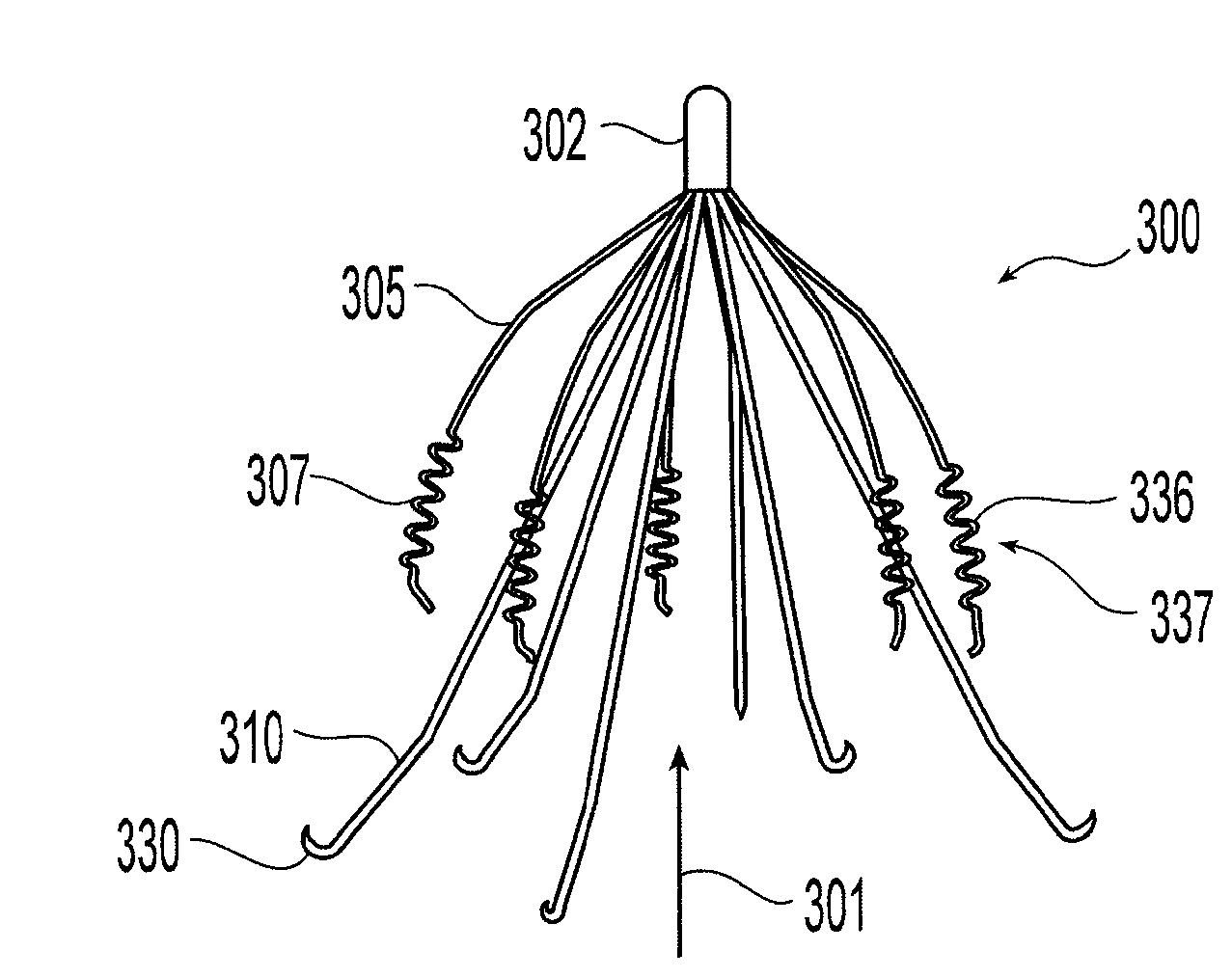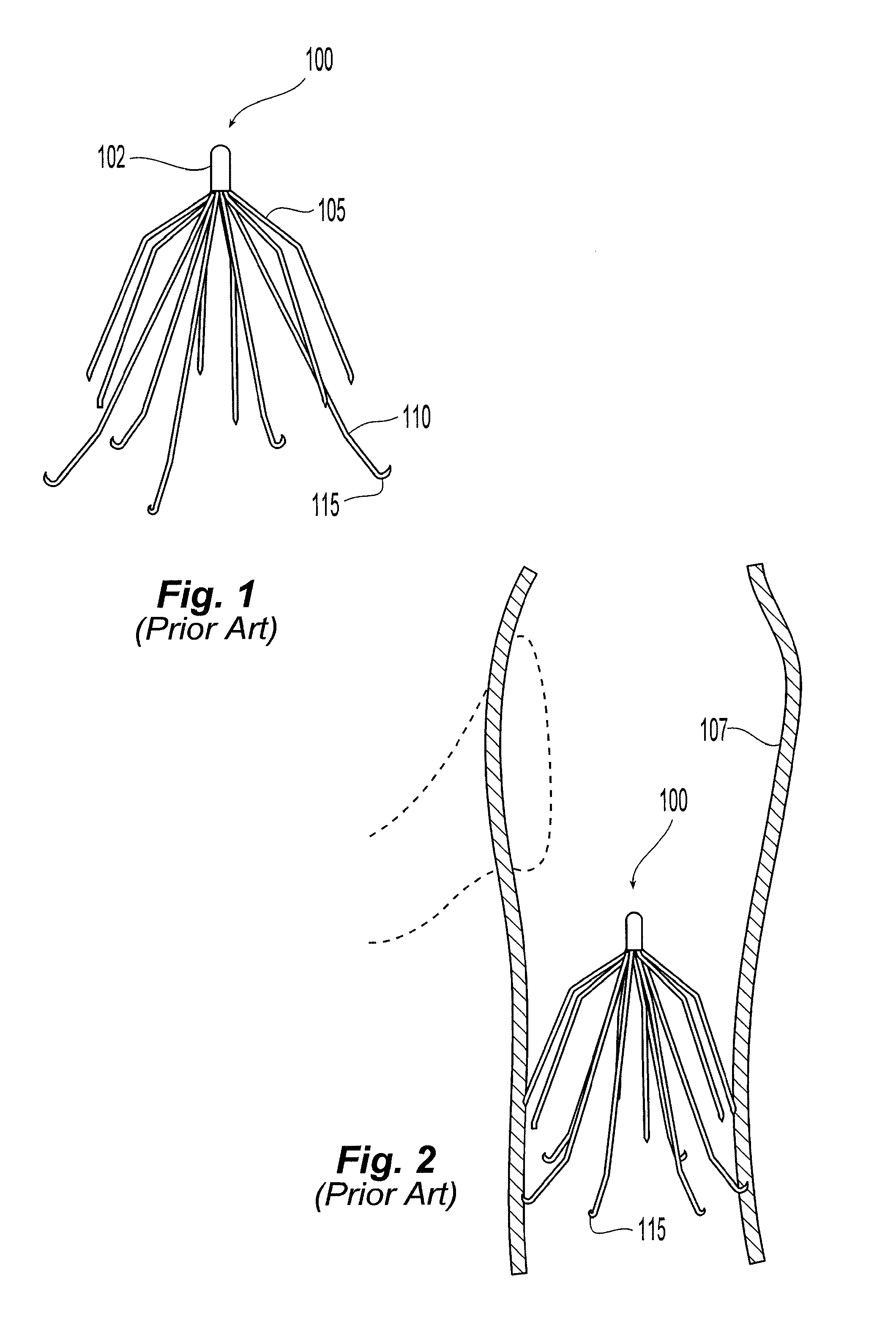[0019]According to the exemplary embodiments, there is provided, a vessel-implantable filter of shape memory material with
temperature induced austenitic and
martensite states which may be easily removed by a single removal device after an extended period of time without significantly injuring the vessel wall. In the exemplary embodiments, the filter is of shape memory material which operates in a
temperature induced austenitic state to exert a force on the wall of a vessel by means of oppositely disposed second extension elements to maintain the filter in place, but which may easily be removed after the
endothelium layer has covered the ends of the filter second extension elements without significant damage to the vessel wall.
[0021]Preferably, the hooks are elastic and formed on the free end of an
appendage to pierce the vessel wall and insure that the filter remains stable even in response to movement, such as respiratory functions or in the event of a massive
pulmonary embolism. The hook is formed to have a maximum migration force, and when subjected to forces below the maximum migration force, the hook retains its shape. When subjected to forces above the maximum migration force, the hook straightens and can automatically disengage without significant damage to the vessel wall.
[0024]In a preferred variation of the foregoing embodiment, the appendages are arrayed in two circular arrays which are offset or spaced along the axial direction. In this case, the appendages at one end may be referred to as second extension elements and the appendages at the other end may be referred to as first extension elements. More preferably, both the first extension elements and the second extension elements have features at their extreme ends which are designed to engage the wall of a
vena cava in such a way as to
resist axial force. Preferably, the total force the appendages / tips can
resist is no more than that required to
resist blood flow pressure of 50 mm Hg over the cross-sectional area of the vessel. By providing some support from the first extension elements as well as the second extension elements, the total force per axial-load-resisting contact point is reduced. For example, if the tips are sharp and penetrate the vessel wall, the load per vessel-wall penetration is thereby reduced, causing
reduced risk of trauma, particularly upon withdrawal of the filter.
[0026]Preferably, the second surfaces are more effective to prevent upstream movement than to prevent downstream movement. Preferably, each of the second surfaces defines a sharp tip that is angled such that the tip tends to withdraw from the vessel wall if the second portion of the wall-contacting elements is moved in the downstream direction. Preferably, the second portion of the wall-contacting elements are configured to buckle, thereby changing the angles of the sharp tips such that the sharp tips tend to withdraw from the vessel wall on upstream movement. Also, in a variant embodiment, the second portion of the wall-contacting elements are configured to buckle when the filter moves in an upstream direction. Also, in another variant embodiment, the wall contacting surfaces of the first and second portion of the wall-contacting members are axially displaced relative to each other to serve to orient the filter in the
blood vessel. In yet another a variant embodiment, the first portion of the wall-contacting members have respective weakened portions that are shaped to limit the amount of radial force the first surfaces apply to the vessel wall.
[0032]According to an embodiment, a blood clot filter has a hub extending in a hub direction from a first hub end to a second hub end along a longitudinal axis. A plurality of second extension elements extend away from the second hub end along the longitudinal axis, each of the second extension elements having a second extension element end
proximate the hub and a hook at or near a distal end of the second extension element to retain the second extension element to a
blood vessel wall. A plurality of first extension elements extend away from the second hub end along the longitudinal axis. Each of the first extension elements has a first end and free end, the first end of each first extension element preferably being contiguous with a portion of the second extension element. In addition, the free end of each first extension element is preferably closer to the axis of the filter than the hook of each second extension element. Moreover, the free ends of each of the first extension elements are preferably spaced equiradially from the longitudinal axis. At least some of the first extension element free ends have features to engage the vessel inner wall to promote stability of the filter.
[0034]According to an embodiment, a blood clot filter has a hub extending in an axial direction with radially extending elements having vessel wall-engaging ends. First radially extending elements have first wall-engaging ends configured to engage a vessel interior wall and thereby prevent downstream movement of the filter. Second radially extending elements having second wall-engaging ends configured to engage a vessel interior wall and thereby prevent upstream movement of the filter. The second radially extending elements are preferably configured to bend more easily in a first direction than a second.
 Login to View More
Login to View More  Login to View More
Login to View More 


